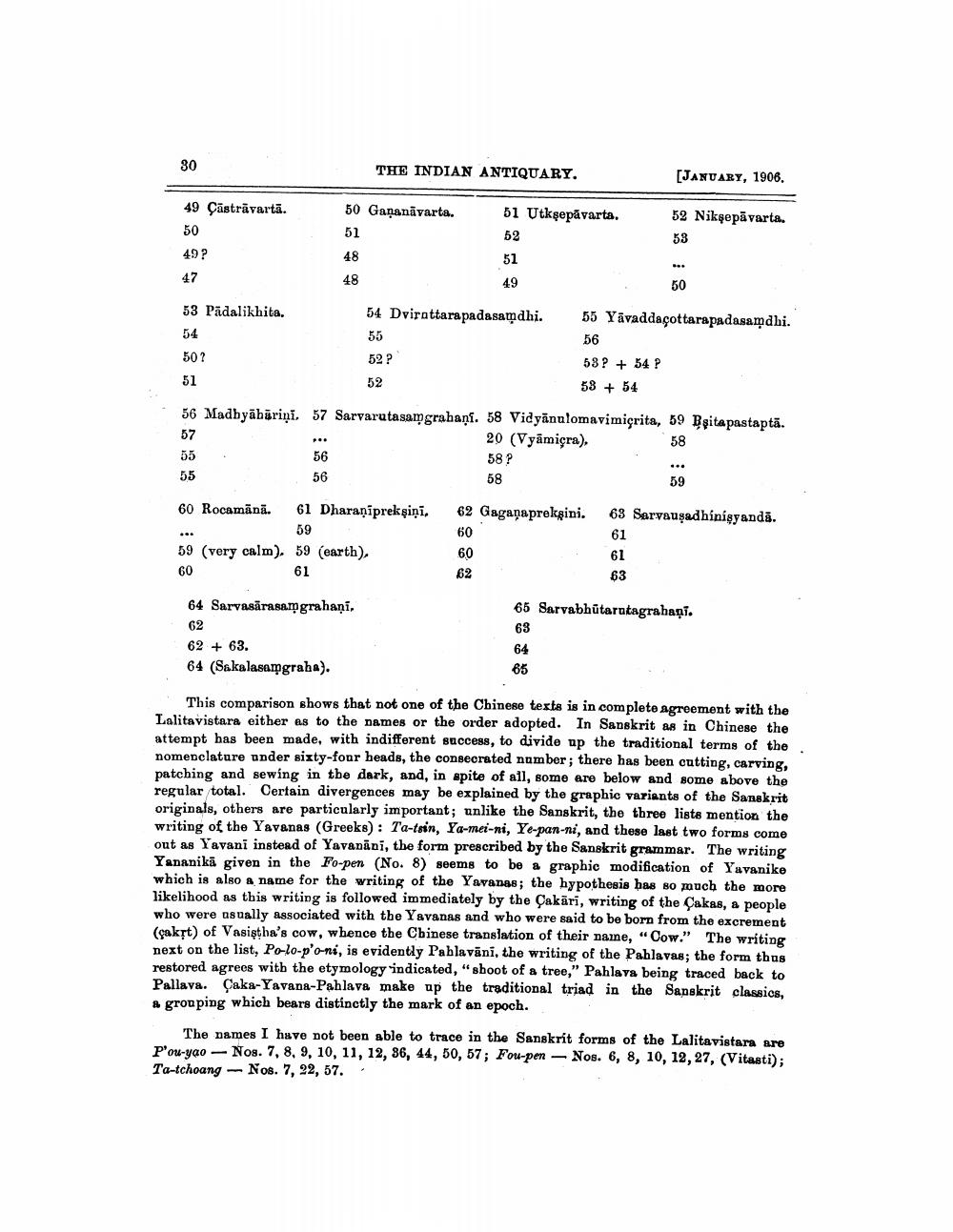________________
30
THE INDIAN ANTIQUARY.
[JANUARY, 1906.
50 Gananāvarta.
49 Çāstrāvartā. 50 49?
51 Utkşepăvarta. 52 51
52 Nikçepāvarta. 53
53 Padalikhita.
54 Dvirattarapadasamdhi. 55 Yavaddacottarapadasamdhi. 54 55
56 50 ? 52 ?
53 ? + 54 ? 52
53 + 54 56 Madhyābāriņi. 57 Sarvarutasamgrahaņi. 58 Vidyānulomavimiçrita, 59 Bşitepastaptā.
20 (Vyāmigra),
58 55 .
56
56
58 ?
58
62 Gaganaprekgini.
60 Rocamānā. 61 Dharanīprekşiņi.
59 59 (very calm). 59 (earth),
61
63 Sarvauşadhinigyandā. 61 61
63
65 Sarvabhūtarutagrahaņi.
64 Sarvasārasamgrahani, 62 62 + 63. 64 (Sakalasamgraha).
64
65
This comparison shows that not one of the Chinese texts is in complete agreement with the Lolitavistara either as to the names or the order adopted. In Sanskrit as in Chinese the attempt has been made, with indifferent success, to divide up the traditional terms of the nomenclature under sixty-four heads, the consecrated number; there has been cutting, carving, patching and sewing in the dark, and, in spite of all, some are below and some above the regular total. Certain divergences may be explained by the graphic variants of the Sanskrit originals, others are particularly important; unlike the Sanskrit, the three lists mention the writing of the Yavanas (Greeks): Ta-tsin, Ya-mei-ni, Ye-pan-ni, and these last two forms come out as Yavani instead of Yavanāni, the form prescribed by the Sanskrit grammar. The writing Yananika given in the Fo-pen (No. 8) seems to be a graphic modification of Yuvanike which is also a name for the writing of the Yavanas; the hypothesis has so much the more likelihood as this writing is followed immediately by the Çakäri, writing of the Cakas, a people who were usually associated with the Yavanas and who were said to be born from the excrement (sakrt) of Vasiştha's cow, whence the Chinese translation of their name, “Cow." The writing next on the list, Po-lo-p'o-ni, is evidently Pablavāni, the writing of the Pahlavas; the form thus restored agrees with the etymology indicated, "sboot of a tree," Pahlava being traced back to Pallava. Çaka-Yavana-Pahlava make up the traditional triad in the Sanskrit classics, * grouping which bears distinctly the mark of an epoch.
The names I have not been able to trace in the Sanskrit forms of the Lalitavistara are P'ou-yao - Nos. 7, 8, 9, 10, 11, 12, 86, 44, 50, 57; Fou-per - Nos. 6, 8, 10, 12, 27, (Vitasti); Ta-tchoang - Nos. 7, 22, 57..




